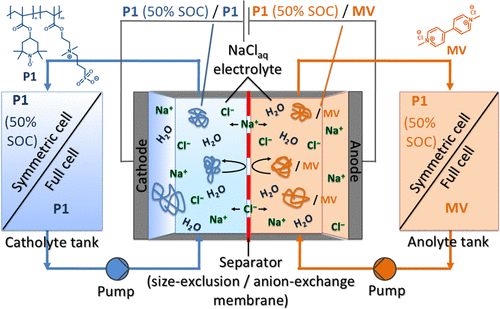当前位置:
X-MOL 学术
›
Chem. Mater.
›
论文详情
Our official English website, www.x-mol.net, welcomes your
feedback! (Note: you will need to create a separate account there.)
(2,2,6,6-Tetramethylpiperidin-1-yl)oxyl-Containing Zwitterionic Polymer as Catholyte Species for High-Capacity Aqueous Polymer Redox Flow Batteries
Chemistry of Materials ( IF 7.2 ) Pub Date : 2019-09-16 , DOI: 10.1021/acs.chemmater.9b02201 Tino Hagemann 1, 2 , Maria Strumpf 1, 2 , Erik Schröter 1, 2 , Christian Stolze 1, 2 , Mandy Grube 1, 3 , Ivo Nischang 1, 3 , Martin D. Hager 1, 2, 3 , Ulrich S. Schubert 1, 2, 3
Chemistry of Materials ( IF 7.2 ) Pub Date : 2019-09-16 , DOI: 10.1021/acs.chemmater.9b02201 Tino Hagemann 1, 2 , Maria Strumpf 1, 2 , Erik Schröter 1, 2 , Christian Stolze 1, 2 , Mandy Grube 1, 3 , Ivo Nischang 1, 3 , Martin D. Hager 1, 2, 3 , Ulrich S. Schubert 1, 2, 3
Affiliation

|
Herein, we present a novel copolymer (1), which incorporates (2,2,6,6-tetramethylpiperidin-1-yl)oxyl (TEMPO) as a redox-active compound and the zwitterionic [(2-(methacryloxy)ethyl)dimethyl-(3-sulfopropyl)]ammonium hydroxide as a solubilizing comonomer, for the application as catholyte species within aqueous redox flow batteries (RFBs). The presented polymer-based redox-active material exhibits a high degree of oxidation and, compared to other commonly utilized active polymeric materials, a high solubility exceeding 20 Ah L–1, while still featuring a low viscosity in 1.5 M NaClaq solution. The electrochemical behavior was investigated by cyclic voltammetry, and a reversible redox reaction at E0 = 0.7 V versus the Ag/AgCl reference electrode of the TEMPO/TEMPO+ redox pair was observed. Symmetric design battery studies with two different types of membranes, a size-exclusion versus an anion-exchange membrane, were used to evaluate the applicability of this polymer in the RFB setup. Long-term stability tests over 1000 cycles indicate good stability with a capacity loss of ca. 0.08% per cycle utilizing a size-exclusion and an anion-exchange membrane, respectively. Finally, an all-organic aqueous RFB was operated utilizing 1 as the catholyte species and N,N′-dimethyl-4,4′-bipyridinium dichloride (MV) as the anolyte species. Such RFB exhibits Coulombic efficiencies of 99.01 ± 1.40% over 125 consecutive cycles, an energy efficiency of ca. 93%, and an initial energy density of 5.33 Wh L–1 during the studied discharge process.
中文翻译:

含(2,2,6,6-四甲基哌啶-1-基)氧基的两性离子聚合物作为高容量水性聚合物氧化还原液流电池的阴极物质
在这里,我们提出了一种新型的共聚物(1),其中掺入了作为氧化还原活性化合物的(2,2,6,6-四甲基哌啶-1-基)氧基(TEMPO)和两性离子的[(2-(甲基丙烯酰氧基)乙基]二甲基-(3-磺丙基)氢氧化铵作为增溶共聚单体,用作水性氧化还原液流电池(RFB)中的阴极电解液。提出的基于聚合物的氧化还原活性材料表现出很高的氧化度,与其他常用的活性聚合物材料相比,具有超过20 Ah L –1的高溶解度,同时在1.5 M NaCl水溶液中的粘度仍然很低。通过循环伏安法研究电化学行为,并在E 0下进行可逆的氧化还原反应。相对于TEMPO / TEMPO +氧化还原对的Ag / AgCl参比电极为0.7V 。使用两种不同类型的膜(尺寸排阻膜与阴离子交换膜)进行对称设计电池研究,以评估该聚合物在RFB装置中的适用性。超过1000个循环的长期稳定性测试表明,稳定性良好,容量损失约为。每次使用大小排阻膜和阴离子交换膜分别为0.08%。最后,使用1作为阴极电解质种类和N,N'-二甲基-4,4'-二氯化吡啶鎓(MV)作为阳极电解液种类。这样的RFB在125个连续循环中表现出99.01±1.40%的库仑效率,能量效率约为。93%,在研究的放电过程中的初始能量密度为5.33 Wh L –1。
更新日期:2019-09-16
中文翻译:

含(2,2,6,6-四甲基哌啶-1-基)氧基的两性离子聚合物作为高容量水性聚合物氧化还原液流电池的阴极物质
在这里,我们提出了一种新型的共聚物(1),其中掺入了作为氧化还原活性化合物的(2,2,6,6-四甲基哌啶-1-基)氧基(TEMPO)和两性离子的[(2-(甲基丙烯酰氧基)乙基]二甲基-(3-磺丙基)氢氧化铵作为增溶共聚单体,用作水性氧化还原液流电池(RFB)中的阴极电解液。提出的基于聚合物的氧化还原活性材料表现出很高的氧化度,与其他常用的活性聚合物材料相比,具有超过20 Ah L –1的高溶解度,同时在1.5 M NaCl水溶液中的粘度仍然很低。通过循环伏安法研究电化学行为,并在E 0下进行可逆的氧化还原反应。相对于TEMPO / TEMPO +氧化还原对的Ag / AgCl参比电极为0.7V 。使用两种不同类型的膜(尺寸排阻膜与阴离子交换膜)进行对称设计电池研究,以评估该聚合物在RFB装置中的适用性。超过1000个循环的长期稳定性测试表明,稳定性良好,容量损失约为。每次使用大小排阻膜和阴离子交换膜分别为0.08%。最后,使用1作为阴极电解质种类和N,N'-二甲基-4,4'-二氯化吡啶鎓(MV)作为阳极电解液种类。这样的RFB在125个连续循环中表现出99.01±1.40%的库仑效率,能量效率约为。93%,在研究的放电过程中的初始能量密度为5.33 Wh L –1。





















































 京公网安备 11010802027423号
京公网安备 11010802027423号